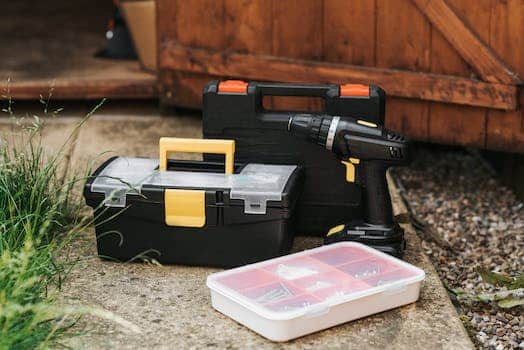To lubricate your garage door, follow these simple steps:
1. Gather the necessary materials: You will need a lubricant specifically designed for garage doors. Look for one that is silicone-based as it doesn’t attract dirt or dust. Additionally, you may need a ladder or step stool, a clean cloth, and gloves.
2. Clean the tracks: Begin by wiping down the tracks with a clean cloth to remove any dirt or debris. This will ensure that the lubricant can work effectively.
3. Apply lubricant to the tracks: Using the silicone-based lubricant, apply a small amount along the length of each track. Be sure to coat both the inside and outside edges of the tracks. Avoid using excessive amounts as it can lead to a messy buildup.
4. Lubricate the rollers: Locate the rollers on either side of the garage door. Apply a few drops of lubricant to each roller, ensuring they are adequately coated. Roll the door manually a few times to distribute the lubricant evenly.
5. Lubricate the hinges: Apply lubricant to all hinges connecting the garage door sections. Again, a few drops on each hinge should be sufficient. Open and close the door a few times to spread the lubricant evenly.
6. Lubricate the springs: Be cautious when lubricating the springs, as they are under tension and can be dangerous if mishandled. Apply a small amount of lubricant to the springs using a cloth or brush. Exercise caution and avoid touching the springs directly.
7. Test the door: Once you have completed lubricating all the necessary parts, open and close the garage door a few times to ensure smooth operation. The lubricant should reduce any creaking or sticking noises, allowing the door to move more easily.
Remember to consult your garage door manufacturer’s guidelines for any specific instructions or restrictions regarding lubrication. With regular lubrication, your garage door should operate smoothly and quietly for years to come. 
Why Lubricating Your Garage Door is Important
Regular maintenance is essential to keep your garage door functioning smoothly and prolong its lifespan. One crucial aspect of maintenance is lubricating your garage door components. Lubrication not only reduces friction but also prevents unnecessary wear and tear. In this article, we will discuss the importance of lubricating your garage door and provide some useful tips.
The Benefits of Lubrication
1. Improved Performance:
- Lubricating your garage door ensures smooth movement of its parts, allowing it to open and close effortlessly.
- Reduced noise: Proper lubrication minimizes the noise generated during the operation of your garage door, providing a quiet and peaceful environment.
- Increased efficiency: A well-lubricated garage door requires less power to operate, leading to energy savings in the long run.
2. Prevention of Damage:
- By reducing friction, lubrication prevents excessive strain on the garage door opener and other components, minimizing the risk of damage.
- Regular lubrication protects moving parts from corrosion, rust, and other forms of deterioration caused by moisture and climate conditions.
When to Lubricate Your Garage Door
It is recommended to lubricate your garage door at least twice a year, preferably during spring and autumn. However, it is important to inspect your garage door and lubricate it more frequently if you notice any of the following:
- Squeaking or grinding noises during operation
- Stiff or jerky movements
- Visible signs of rust or corrosion
How to Lubricate Your Garage Door
Follow these simple steps to ensure effective lubrication of your garage door:
- Start by cleaning the tracks and removing any dirt or debris using a damp cloth or mild cleaner.
- Apply a silicone-based lubricant to the hinges, rollers, tracks, and springs. Avoid using WD-40 or similar products as they can attract dirt and cause buildup over time.
- Gently move the door up and down to distribute the lubricant evenly.
- Wipe off any excess lubricant to prevent drips or buildup.
Remember, proper lubrication is vital for maintaining the performance and longevity of your garage door. Taking the time to lubricate it regularly will save you from costly repairs and ensure smooth operation for years to come.
In conclusion, lubricating your garage door is an essential maintenance task that should not be overlooked. Regular lubrication provides numerous benefits, including improved performance, reduced noise, and protection against damage. By following the recommended lubrication schedule and techniques, you can ensure that your garage door operates smoothly and efficiently. So don’t forget to include lubrication in your routine garage door maintenance.
Step-by-Step Guide: How to Lubricate Your Garage Door
Is your garage door making squeaking noises? Does it feel stiff and difficult to open or close? If the answer is yes, then it’s time to give your garage door some much-needed lubrication. Regular lubrication not only ensures smooth operation but also extends the lifespan of your garage door. In this guide, we will walk you through the steps to properly lubricate your garage door.
Why lubricating your garage door is important
Over time, the moving parts of your garage door, such as hinges, rollers, and tracks, can accumulate dust and dirt. This buildup can cause friction, leading to noisy operation and potential damage to the door’s components. By regularly lubricating your garage door, you can prevent these issues and maintain its optimal performance.
What you will need
- Silicone-based garage door lubricant
- Clean cloth
Step 1: Clean the tracks
Before lubricating, it’s important to clean the tracks of your garage door. Use a clean cloth to remove any dirt or debris that may have accumulated on the tracks. This will ensure that the lubricant can properly penetrate and provide the desired effect.
Step 2: Lubricate the hinges
Apply a small amount of silicone-based lubricant to each hinge, both on the door and the frame. Be sure to move the door up and down a few times to spread the lubricant evenly. This will prevent any binding and ensure smooth operation.
Step 3: Lubricate the rollers
Next, apply lubricant to the rollers of your garage door. Start by applying a small amount to each roller, allowing it to spread across the entire surface. Again, move the door up and down a few times to distribute the lubricant effectively. This will reduce friction and noise during operation.
Step 4: Lubricate the tracks
Apply a thin layer of lubricant to the inside of the tracks on both sides. Make sure to cover the entire length of the track. Opening and closing the door a few times will help distribute the lubricant evenly and ensure smooth movement.
Step 5: Wipe off excess lubricant
After applying the lubricant, use a clean cloth to wipe off any excess. Leaving excess lubricant can attract dirt and dust, counteracting the desired effect. Wiping off the excess will also give your garage door a clean and polished look.
And there you have it – a freshly lubricated garage door! By following these simple steps regularly, you can keep your garage door operating smoothly and quietly for years to come. Remember, proper lubrication not only extends the lifespan of your garage door but also ensures its optimal performance.

Best Lubricants for Garage Doors: Which One Should You Use?
When it comes to maintaining your garage door, using the right lubricant is crucial for smooth operation and longevity. The lubricant you choose can greatly impact the performance and lifespan of your garage door.
Types of Lubricants
There are several types of lubricants available in the market for garage doors. Each type has its own advantages and disadvantages. Here are some of the most common types:
| Type | Advantages | Disadvantages |
|---|---|---|
| Silicone-based lubricants | Long-lasting, doesn’t attract dust | May be more expensive |
| White lithium grease | Water-resistant, suitable for extreme temperatures | May attract dust |
| WD-40 | Multi-purpose, penetrates rust | Not long-lasting, may require frequent re-application |
It’s important to choose a lubricant that is specifically designed for garage doors. Avoid using household lubricants like cooking oil or petroleum jelly, as they can cause buildup and damage the door mechanism.
How to Lubricate Your Garage Door
Proper lubrication is essential for ensuring the smooth operation of your garage door. Here’s a step-by-step guide to lubricating your garage door:
- Start by cleaning the door tracks and rollers using a mild household cleaner and a clean cloth. Remove any dirt, debris, or old lubricant.
- Apply a small amount of lubricant to the hinges, springs, and bearings. Avoid excessive lubrication as it can attract more dirt and create a mess.
- Operate the garage door a few times to evenly distribute the lubricant and ensure smooth movement. Check for any excessive noise or friction.
Regular lubrication should be done at least once a year to maintain the performance and longevity of your garage door.
Conclusion
Choosing the right lubricant for your garage door is essential for its proper functioning and durability. Silicone-based lubricants, white lithium grease, and WD-40 are some of the commonly used options. Remember to clean the door mechanism before applying lubricant and avoid using household lubricants. Regular maintenance and lubrication will help extend the lifespan of your garage door and ensure smooth and quiet operation.

Common Mistakes to Avoid When Lubricating Your Garage Door
Proper maintenance of your garage door is important to ensure smooth operation and prolong its lifespan. One essential maintenance task is regular lubrication. However, there are common mistakes that you should avoid when lubricating your garage door to maximize its performance.
Using the Wrong Lubricant
Using the wrong lubricant is a common mistake that can lead to serious issues with your garage door. It’s crucial to use a lubricant specifically designed for garage doors, such as a silicone-based spray or a lithium grease. These lubricants provide the necessary protection against rust and friction without causing buildup or damage to the door components.
Over-Lubricating
While lubrication is important, it’s crucial not to overdo it. Applying too much lubricant can actually do more harm than good. Excess lubricant can attract dirt and debris, leading to a buildup that can interfere with the door’s smooth operation. Follow the manufacturer’s recommendations on the amount of lubricant to use and apply it sparingly to the necessary parts, such as the roller bearings, hinges, and springs.
Ignoring the Tracks and Rollers
When lubricating your garage door, it’s important not to neglect the tracks and rollers. These components play a crucial role in the door’s movement. Clean the tracks thoroughly and apply lubricant to ensure smooth and quiet operation. Regular maintenance of the tracks and rollers can prevent issues such as misalignment and noisy operation.
Not Cleaning Before Lubricating
Before applying lubricant, it’s important to clean the parts thoroughly. Dust, dirt, and debris can accumulate on the door components, hindering their proper function. Use a soft cloth or a brush to remove any dirt or debris from the hinges, springs, or rollers. This will ensure that the lubricant can penetrate properly and provide effective protection.
Skipping Regular Maintenance
Regular maintenance is key to preventing issues with your garage door. Don’t wait until problems arise to lubricate your door. Implement a regular maintenance schedule, ideally every six months, to keep your garage door in optimal condition. Regular lubrication will minimize friction, reduce wear and tear, and extend the life of your garage door.
- Use a lubricant specifically designed for garage doors
- Apply lubricant sparingly to avoid buildup
- Don’t neglect the tracks and rollers
- Clean the parts thoroughly before lubricating
- Implement a regular maintenance schedule
By avoiding these common mistakes and following proper lubrication techniques, you can keep your garage door functioning smoothly and avoid costly repairs in the future. Regular maintenance and proper lubrication will ensure that your garage door operates efficiently for years to come.
Signs that Your Garage Door Needs Lubrication
Your garage door is an essential component of your home that provides security and convenience. To ensure its smooth operation and prolong its lifespan, proper maintenance is crucial. One often overlooked aspect is lubrication. In this article, we will discuss the signs that indicate your garage door needs lubrication and walk you through the steps of lubricating it effectively.
Why is Garage Door Lubrication Important?
Before diving into the signs that your garage door requires lubrication, let’s first understand why lubrication is vital. The moving parts of your garage door, such as hinges, rollers, and tracks, constantly undergo friction and wear. Lubrication reduces these effects by creating a protective layer, preventing metal-on-metal contact, and ensuring smooth, quiet operation. Neglecting proper lubrication can lead to premature component failure, costly repairs, and noisy operation.
Signs that Your Garage Door Needs Lubrication
1. Noise: Is your garage door making unusual noises during operation? A squeaky or grinding sound indicates that the moving parts lack lubrication. Regularly lubricating these parts can significantly reduce noise levels and enhance the overall functionality of the garage door.
2. Slow Movement: Does your garage door move slower than usual? If you notice a decrease in speed or jerky movement, insufficient lubrication could be the culprit. Lubricating the hinges, springs, and rollers will improve their efficiency and ensure a smooth, seamless operation.
3. Stiffness: When opening or closing your garage door, do you encounter resistance or stiffness? This resistance may be due to dry or rusty components. Applying lubrication to the hinges, tracks, and springs will eliminate the stiffness and allow for easy, hassle-free movement.
4. Vibrations: Excessive vibrations during the operation of your garage door indicate that the moving parts are not adequately lubricated. Proper lubrication reduces friction, minimizes vibrations, and promotes a quieter and more efficient performance.
How to Lubricate Your Garage Door
Now that you are aware of the signs that your garage door needs lubrication, it’s time to learn the correct method of lubricating it.
| Component | Recommended Lubricant |
|---|---|
| Hinges | Silicone-based lubricant |
| Rollers | Silicone-based lubricant |
| Tracks | White lithium grease |
| Springs | Spray lubricant |
Note: Before lubricating, ensure that your garage door is closed and the power is disconnected to prevent accidents.
1. Start by cleaning the components. Use a cloth or brush to remove dirt, debris, and old lubricant from the hinges, rollers, tracks, and springs.
2. Apply the appropriate lubricant to each component based on the table above. Be sure to follow the manufacturer’s instructions for the specific lubricant.
3. After lubricating, manually operate the garage door a few times to distribute the lubricant evenly. This also allows you to identify any areas that may require additional lubrication.
4. Wipe off any excess lubricant with a clean cloth to prevent build-up and accumulation of dirt and grime.
Regular lubrication is essential to maintain the smooth and efficient operation of your garage door. By following these steps and addressing the signs of inadequate lubrication promptly, you can prolong the lifespan of your garage door and avoid unnecessary repairs.
SSS (FAQ)
1. Why is it important to lubricate a garage door?
Lubricating a garage door helps prevent wear and tear on its moving parts, reduces noise, and extends the lifespan of the door.
2. How often should I lubricate my garage door?
It is recommended to lubricate your garage door at least once a year. However, if you notice any signs of stiffness or noise, lubricate it more frequently.
3. What type of lubricant should I use for my garage door?
You should use a silicone-based lubricant specifically designed for garage doors. Avoid using WD-40 or oil-based lubricants as they can attract dust and dirt.
4. Which parts of the garage door should I lubricate?
You should lubricate the hinges, rollers, springs, tracks, and bearings of your garage door.
5. How do I lubricate the hinges of my garage door?
Apply a small amount of lubricant to each hinge, focusing on the pivot points. Use a cloth to wipe off any excess lubricant.
6. How do I lubricate the rollers of my garage door?
Apply lubricant to the roller bearings. Avoid spraying lubricant on the tracks as it can cause the rollers to slip.
7. Can I use WD-40 to lubricate my garage door?
No, it is not recommended to use WD-40 as it can attract dust and dirt, which can hinder the smooth functioning of your garage door.
8. How do I lubricate the springs of my garage door?
Apply a small amount of lubricant to each spring. Be cautious while working with springs as they are under tension. If unsure, it’s best to seek professional help.
9. How do I lubricate the tracks of my garage door?
Apply a small amount of lubricant to a cloth and wipe it along the tracks. Avoid over-lubricating, as it can attract debris.
10. How can I reduce the noise of my garage door?
Lubricating the moving parts of your garage door can significantly reduce noise. Additionally, check and tighten any loose nuts and bolts.
11. Can I use cooking oil to lubricate my garage door?
No, cooking oil is not recommended as it can become sticky over time and attract dust and debris, causing more harm than good.
12. Should I lubricate the garage door opener?
No, you should not lubricate the garage door opener. The opener has its own maintenance requirements, so refer to the manufacturer’s instructions for proper care.
13. Can I lubricate my garage door myself?
Yes, lubricating your garage door is a simple task that you can do yourself. Just ensure you follow the manufacturer’s guidelines and safety precautions.
14. What should I do if my garage door still makes noise after lubrication?
If your garage door continues to make noise after lubricating, you may have other underlying issues. It’s advisable to consult a professional garage door technician for further inspection.
15. Can lubricating a garage door fix all its problems?
No, lubricating a garage door can help with smooth operation and prevent certain issues, but it may not fix all problems. Some issues may require professional repair or replacement.




